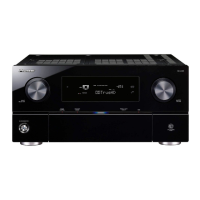The Advanced MCACC menu
07
50
En
The graph below shows the difference between
conventional acoustic calibration and professional
calibration (the gray circle indicates the point where the
microphone captures sound during frequency analysis).
As soon as audio is output from your speaker system, it
is influenced by room characteristics, such as walls,
furniture, and the dimensions of the room. The sooner
the frequency analysis, the less it is influenced by the
room. We recommend an earlier time setting of
30~50ms to compensate for two major factors that will
influence the sound of most rooms:
• Reverberance of high vs. low frequencies –
Depending on your room, you may find that lower
fre
quencies seem overly
reverberant compared to
higher frequencies (i.e. your room sounds ‘boomy’).
This may result in a skewed frequency analysis if the
measurement is done too late.
• Reverb characteristics for different channels –
Reverb characteristics can be somewhat different for
each channel. Since this difference increases as the
sound is influenced by the various r oom
characteristics, it is often better to capture a
frequency analysis early on for smoother mixing of
channel frequencies/sounds.
If your room isn’t affected by the factors above, it is often
not necessary to make a 30~50ms setting. Later time
settings may provide a more detailed sound experien
ce
wi
th your speaker system. It is best to try and see what
works best for your particular room.
Note that changing the room (for example, moving
furniture or p aintings) will affect the calibration results.
In such cases, you should recalibrate your system.
Using Acoustic Calibration EQ Professional
1 Select ‘
EQ Professional
’, then press
ENTER
.
2 Select an option and press
ENTER
.
• Reverb Measurement – Use this to measure the
reverb characteristics of your room (for graphical
output using a PC, see Connecting a PC for Advanced
MCACC output on page 69 to connect an RS-232C
cable before selecting this option).
• Reverb View – You can check the reverb
measurements made for specified frequency ranges
in each channel.
1
• Advanced EQ Setup – Use this to select the time
period that will be used for fr equency adjustment and
calibration, based on the reverb measurement of
your listening area. Note that customizing system
calibration using this setup will alter the settings you
made in Automatically setting up for surround sound
(MCACC & Full Band Phase Control) on page 9 or
Automatic MCACC (Expert) on page 44 and is not
necessary if you’re satisfied with these settings.
3 If you selected ‘
Reverb Measurement
’, select
EQ
ON
or
OFF
, and then
START
.
Level
Test tone
Acoustic Cal. EQ Pro.
calibration range
Conventional MCACC
EQ calibration range
Time
(in msec)
80 160
Level
Low
frequencies
Acoustic Cal. EQ Pro.
calibration range
Time
(in msec)
0 80 160
High
frequencies
Conventional MCACC
EQ calibration range
Level
Left
surround
Acoustic Cal. EQ Pro.
calibration range
Time
(in msec)
80 160
Right
surround
Conventional MCACC
EQ calibration range
1If the Reverb View procedure is performed after the Automatically setting up for surround sound (MCACC & Full Band Phase Control) on page 9
or Reverb Measurement operation, depending on the standing wave control setting, differences may appear on the reverb graph. With the
Auto MCACC function, the reverberations are measured with the standing waves controlled, so the reverb characteristics graph shows the
characteristics with the effect of the standing waves eliminated. By contrast, the Reverb Measurement function measures the reverberations
without controlling the standing waves, so the graph indicates the reverb characteristics
including the effect of the
standing waves. If you wish
to check the reverb characteristics of the room itself (with the standing waves as such), we recommend using the Reverb Measurement
function.
1. Fine Channel Level
2. Fine SP Distance
3. Standing Wave
1c.Manual MCACC
4. EQ Adjust
5. EQ Professional
A/V RECEIVER
Exit Return
a. Reverb Measurement
b. Reverb View
c. Advanced EQ Setup
1c5.EQ Professional
A/V RECEIVER
Exit Return
MCACC : M1.MEMORY 1
1c5a.Reverb Measurement
A/V RECEIVER
Exit Cancel
START
Reverb Measure with : EQ OFF
SCLX81_71.book 50 ページ 2008年7月25日 金曜日 午後3時1分

